Motorising the Crocodile
Posted by Huw,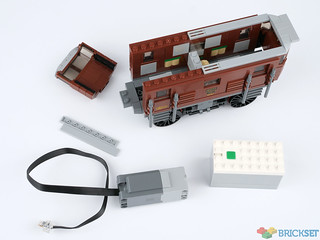
Following on from yesterday's review of 10277 Crocodile Locomotive, in this article I will show you how to motorise it using both Powered Up components, for which it's been designed, and Power Functions, for which it has not.
The central section of the loco has been built with motorisation in mind. The roof and cab ends can be removed easily to access the interior into which you can place a motor on the left and a battery box or hub on the right.
Powered Up!
To motorise it with Powered Up, you will need a 88009 Hub (£45/$50) and a 88013 Technic Large Motor (£30 / $40), a total additional cost of £75 / $90.
Installation is simple: plonk the hub on the right, then use the two Technic pins provided to attach the motor to the central partition.
Then, simply re-attach the cab(s) and roof. Job done.
The Powered Up app is being updated to include a custom controller for this model but at the time of writing it is not yet available. However, expect it to offer speed control and sound effects.
Power Functions
Power Functions is now obsolete although all the parts needed are still in stock at LEGO.com.
The components required are 8883 M-Motor ($7.50 / £6), 8884 IR Receiver ($15 / £11.50) and 8879 IR Speed Remote Control ($13 / £11), plus either 8878 Rechargeable Battery Box ($50 / £43) or 88000 AAA Battery Box ($13 / £12).
That's a total cost of $85 / £71 with the rechargeable battery box or $50 / £40 with the AAA one. However, chances are that you already have these components lying around given they've been around for 10 or so years.
Installing Power Functions is not quite so simple as Powered Up because, in addition to a battery box and motor, you also need to shoehorn an IR receiver in, and manage the cables.
The motor and hub fit in OK, in the same way as the PU components, but there is no room for the IR receiver. Furthermore, the cable from the battery box has to be routed, too.
I mounted the IR receiver on the central divider on top of two 1x1 plates, so that the cable could run under it.
The receiver pokes out the top by quite a way, so the original roof will no longer fit. I therefore made a couple of assembles to fit either side of it that look something like the original.
When it's all assembled it doesn't look horrendous but it's far from ideal, and the attractive ceramic insulators and cables on the roof have been lost.
I don't have a test track to extensively test it to determine whether the medium motor is adequate for the loco to haul any sort of load, but it should be possible to use a PF large motor instead of the medium if it's a problem.
I wanted to see what was possible without a major rebuild of the loco. It can be done if you're happy to accept some cosmetic compromises.
However, if you are prepared to make extensive changes to the structure of the loco you could probably come up with a better solution than this.
If you have neither Powered Up nor Power Functions components I would recommend purchasing the former. However, if you want to make use of Power Functions parts that you already own, you can do so, but expect to have to make changes to the loco if you want a more elegant solution to the one I propose above.
Thanks to LEGO for providing this set for review. All opinions expressed are my own
112 likes

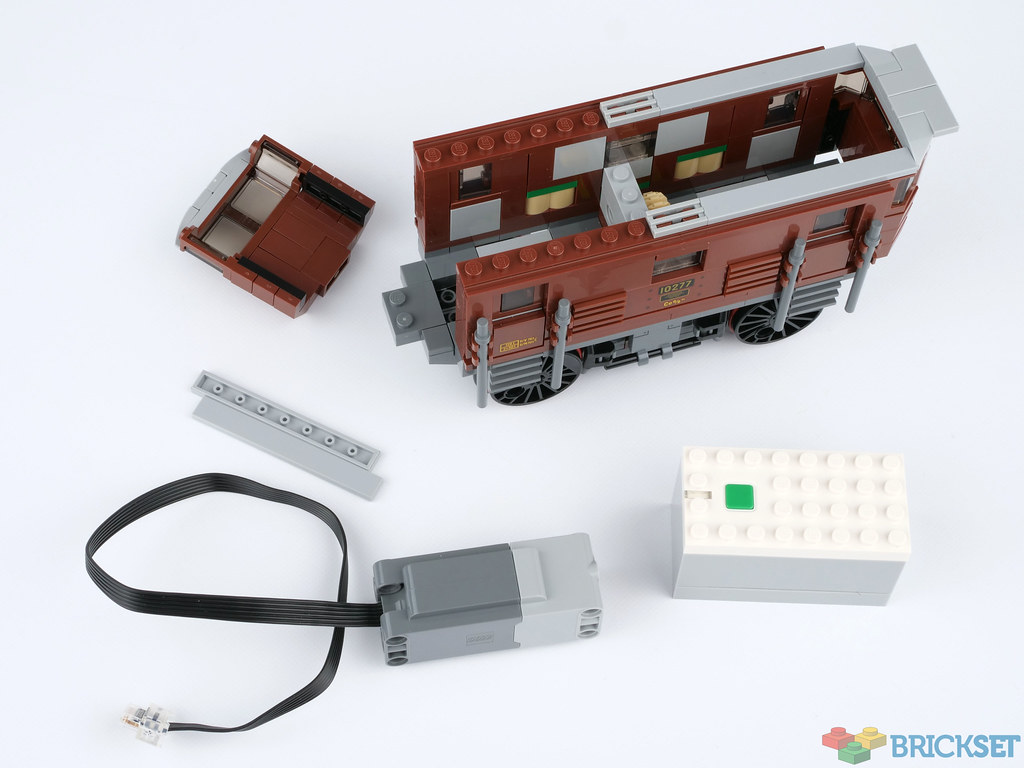


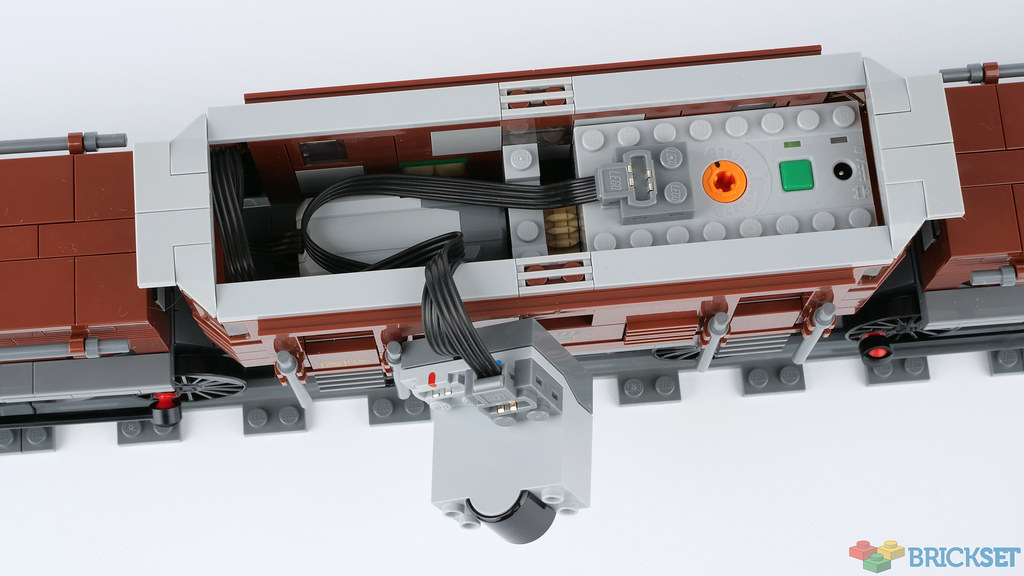

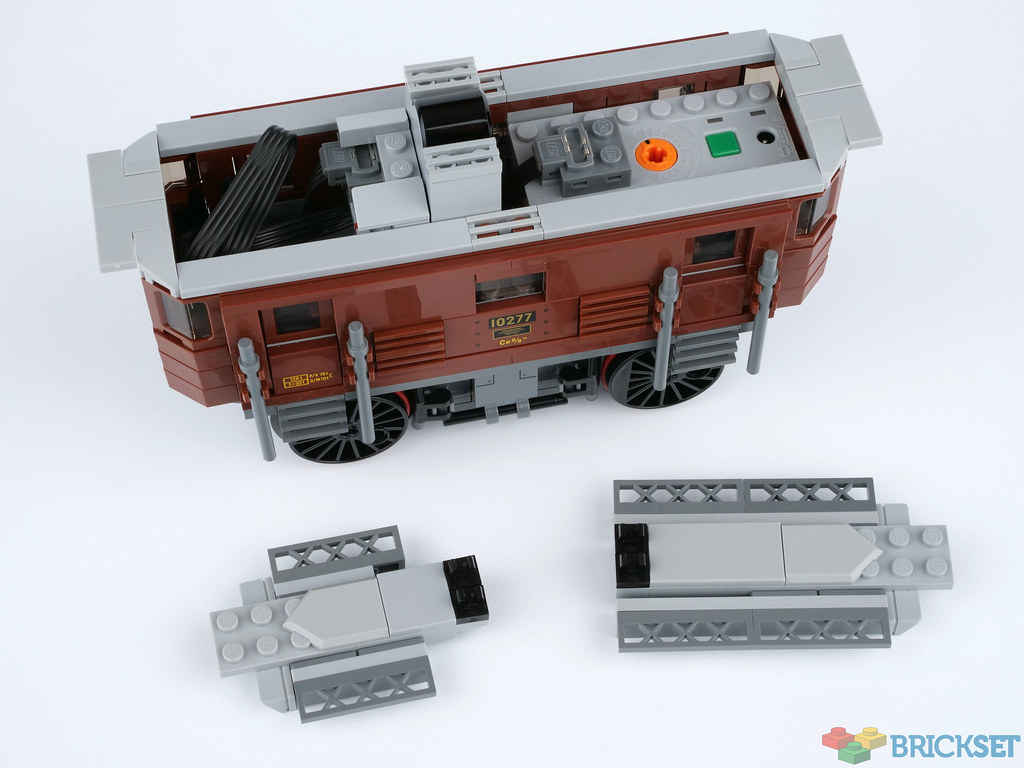


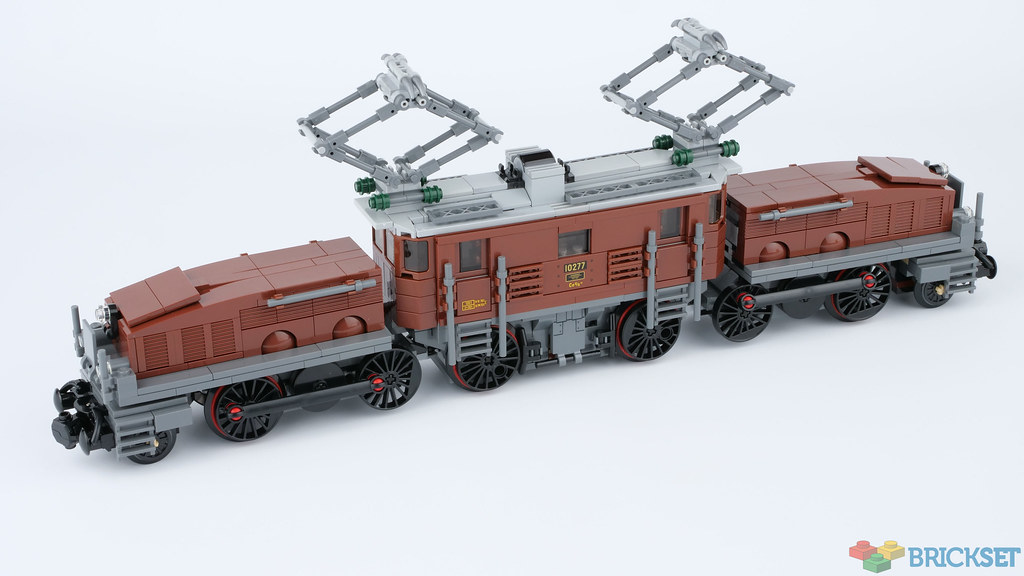
33 comments on this article
A little disappointed motorisation means sacrificing space for the minifigs...In 2020 PU should take up way less space in models, especially for that ridiculous price :/
@mapimi said:
"A little disappointed motorisation means sacrificing space for the minifigs "
In all fairness, how realistic is it that one would look directly into the cabin and see the figures when the train is moving around a track? Not a lot.
Thanks for the review! Anything on the performance? Can't you get some tracks and test how the two ways of moterisation work? Its quite a heavy train, and quite an unusual way of motorising a Lego train.
@CCC , yes, one could do a better job than I did. I didn't want to disassemble the original roof, though.
@chrichrichri, I'll see what I can do.
Even though the Powered Up components are more expensive, I think it is worth it because you don't need to rebuild part of the model and you can use the app, although it doesn't matter for me because I'm not getting this set
@mapimi said:
"A little disappointed motorisation means sacrificing space for the minifigs...In 2020 PU should take up way less space in models, especially for that ridiculous price :/ "
Why? The only difference is the lack of receiver, the battery box still needs to be the same size as does the motor. You can't magically shrink the size of a pack of AAAs or the motor down. The motor sits fairly low so you may be able to fashion a drivers platform for one end of the cab, maybe with just the torso of the minifigure used.
Where can you buy 8878 rechargable battery box for $50?? Everything I find is around 100EUR. :/
Thank you for showing the PF solution, I was wondering how you were going to it as the noses are only 3 brick high from the grey platform whereas you need 4 brick height for the receiver. The Emerald night train used an XL motor but this is too wide for the cabin, so I think you will need a L motor to have enough power to start moving as not a light train. Shame not possible to use a PF or PU train motor directly in either the cabin or the noses as the wheels are 10 and 8 studs apart rather than 6.
@Speedman29 said:
" @mapimi said:
"A little disappointed motorisation means sacrificing space for the minifigs...In 2020 PU should take up way less space in models, especially for that ridiculous price :/ "
Why? The only difference is the lack of receiver, the battery box still needs to be the same size as does the motor. You can't magically shrink the size of a pack of AAAs or the motor down. The motor sits fairly low so you may be able to fashion a drivers platform for one end of the cab, maybe with just the torso of the minifigure used."
Well AAA could be replaced by rechargeable batteries that could be shrunk down to be flat and long for exemple (think cell phone batteries), and motors should be able to be smaller (the train motor has motors that are way smaller than M Motors). I understand that won't happen, but I would like to see more options size wise.
88013 isn’t even available on the Australian shop site, but is in other regions. I’ve emailed them about it, and hopefully it’s rectified by the time this goes on sale; otherwise how do they expect me to motorise it?
Hi there.
Any chance of testing this with the lego bluetooth controller 88010? I prefer to run my trains with this controller and have a spare leftover from when I had to add the second passenger train to turn it into a true electric multiple unit. (Driving cabs both ends 2 motors (traction power spread over multiple carriages) 2 lights controlled by one bluetooth controller). I imagine there might be difficulties as that controller is for the "train motors" not the powered up one used in this set.
Also is there any option to integrate the light (88005) either on the driving cab or on the crocodile "snouts" (for lack of a better term haha) ?
Great reviews as usual on this site! Really enjoying the historical content. And the storage solutions. Keep it up!
Great to see this Huw. How did the engine run, using the medium PF motor, rather than a large one? did it generate enough torque?
@jzque At present, the remote control will only run linear motors (such as the Technic XL) in an 'all or nothing state', compared to the incremental steps with the train motor.
You should be able to use it incrementally, using an intermediate program on the powered up App, to read the remote, and step up the output. It is messy, but unfortunately, all we have to work with at this time.
"Power Functions is now obsolete although all the parts needed are still in stock at LEGO.com."
...including the Rechargeable Battery Box???!!?
Oh, Huw, how you toy with our hopes & dreams... ;-)
@gasdoc said:
"Great to see this Huw. How did the engine run, using the medium PF motor, rather than a large one? did it generate enough torque?
@jzque At present, the remote control will only run linear motors (such as the Technic XL) in an 'all or nothing state', compared to the incremental steps with the train motor.
You should be able to use it incrementally, using an intermediate program on the powered up App, to read the remote, and step up the output. It is messy, but unfortunately, all we have to work with at this time.
"
Thanks for the reply mate. Good to see a fellow aafol (aussie afol) on here.
Thank you for your article about motorizing the Ce 6/8 II locomotive.
I appreciate that you investigated PF also. Is there enough free space in the cab for a 88003 PF L-Motor?
About Power Up: Is this PU Large Motor-HUB setting capable to work with 88010 PU Remote Control?
I am curious because 5-10 years from now, current android version (or even android?) will be obsolete (and I doubt that even if Power up will exist, Lego will maintain the control app. of an 5-10 years old product), so it will be good to see if there is a future proof controlling option?
I wonder why the Technic PU motor is so much more expensive than the white ‘plain’ PU motor...
Hmmm, actually, would the PF IR receiver fit in one of the 'tenders', even it involved running cables both ways and it sticking out a bit?
@brickblues said:
"Where can you buy 8878 rechargeable battery box for $50?? Everything I find is around 100EUR. :/"
I may be wrong, but I thought the rechargeable battery pack was no longer available from LEGO. So the higher price may be from the secondary market.
HUW says, "However, chances are that you already have these components lying around..." Mine are lying around inside my Horizon Express, so I'm not likely to remove it from that train.
I'm not a fan of the Powered UP system but that seems like the simplest motorizing solution.
Presumably, the only option for using an old 9V train motor would be by installing it in a separate truck and using it to push / pull this thing.
Does it like being pushed /pulled?
I'm afraid the crocodile is going to be for display only. I'll leave the PF stuff for my customized trains. Thanks for sharing how to adapt both by the way!
@mapimi:
By taking up all the available space, the motorization rig forces the minifigs to comply with social distancing rules.
@Huw I really hate it when I finish writing something longer and it does not post on submit :( and I forget I should ctrl+c the text before posting case it happens. Some token expired or something as it does it only once it takes 'too long' to write
Now shorter version of original post:
----------------------------------------------------------------
The PF has one advantage that PUp does not have, except for DIYers - extension cables. One can hide the battery box and receiver in the next carriage and just run the cable. The roof stays intact, there is a space for one minifig. Cabling between train cars exists in real life. The only downside is routing it (of course I could not do it on this one but on others yes) and the fixed 1st train carriage.
----------------------------------------------------------------
@merman the new Technic PUp are more like Mindstorms motors - absolute encoders and such. It is more complex than old Servo and that one was costly too. Plus there is the usual price hike by LEGO, even the 'dumb' PUp - WeDo2.0 linear M-motor is 4 Eur more than the PF one. Train motors (also 'dumb') are the same but now without small parts (about 10-15% of price).
^ I did think about putting the IR receiver in a nose but it's 5-wide which makes it awkward if not impossible.
I've motorised the the Wall•E Ideas set with two PF M motors, LEDs and an SBrick+ and powered it with a 9V Battery Box (4760c01pb02) which works great, it's less tall than a PF one. I've never tried to run a train with it though, maybe it runs really slow.
You could put the just the head and hat of the minifigs on the box so you could see it behind the window?
I wonder if you could put the M motor straight up in the center of the cabin and drive the wheels and put the IR receiver behind it? 3+4 studs leaves 1 for cables.. mm..
Honestly really looking forward to this set. For those complaining about PU part prices, on Bricklink under the part name rather than the set name these are less than half the price...
@mapimi said:
"A little disappointed motorisation means sacrificing space for the minifigs...In 2020 PU should take up way less space in models, especially for that ridiculous price :/ "
What do you mean?
You need batteries and these take room.
You also need an electromotor and that takes room too.
And a minifigure in the locomotive can't even been seen.
@Coinoperator said:
" @mapimi said:
"A little disappointed motorisation means sacrificing space for the minifigs...In 2020 PU should take up way less space in models, especially for that ridiculous price :/ "
What do you mean?
You need batteries and these take room.
You also need an electromotor and that takes room too.
And a minifigure in the locomotive can't even been seen."
The PU train hub / PF battery box is only 8 studs long, and you only need about 2 or 3 studs of gap for cables. If there were a way to work the PU motor underneath the hub, there would be space left for minifigs. But the way it's designed, the hub and motor sit level taking up the entire length of the central section of the loco.
@Huw I really hate it when I finish writing something longer and it does not post on submit :( and I forget I should ctrl+c the text before posting case it happens. Some token expired or something as it does it only once it takes 'too long' to write
I face the same problem frequently. Then my summary skills take effect on my second try :P
----------------------
I am personally against any form of software controling things mainly due to softwares/mobiles etc becoming obsolete some time in the future.
Also I don't remember exactly but in the rechargeable battery box you cannot remove the battery when it eventually "dies", while using the AAA battery box, you can easily buy rechargeable batteries when their life expectancy reaches the end.
@blackdeathgr:
You can get limited use of the PU system using the dedicated controllers. The problem is, unlike with PF having train controllers that work one way and remote controls that worked another, PU has train motors that work one way and non-train motors that work differently. That's definitely a problem for train-heads, as they like to use non-train motors to build steam engines
As for the rechargeable box, the main advantage you get from that is that you can plug the charging cable into the battery without having to extract it from the model first. Any time you want to change out regular batteries, you've got to get the battery box completely free of the model to where you can remove the compartment lid. And you _can_ get rechargeable batteries rebuilt, but it's probably not cheap. It also really is dependent on being able to crack the casing open without destroying it.
Oh, this is a train? Looked like a Sandcrawler from the picture.
@JintaiZ: And of course, there's always BrickLink...
@ng272 said:
"Thank you for your article about motorizing the Ce 6/8 II locomotive.
I appreciate that you investigated PF also. Is there enough free space in the cab for a 88003 PF L-Motor?
About Power Up: Is this PU Large Motor-HUB setting capable to work with 88010 PU Remote Control?
I am curious because 5-10 years from now, current android version (or even android?) will be obsolete (and I doubt that even if Power up will exist, Lego will maintain the control app. of an 5-10 years old product), so it will be good to see if there is a future proof controlling option?"
No, the controller (88010) will run the motor full speed one way or the other by holding the plus (+) or minus (-) buttons down. There doesn't seem to be any speed control and you have to hold the button to get movement. Disappointing.
@brickhall said:
" @ng272 said:
"...
About Power Up: Is this PU Large Motor-HUB setting capable to work with 88010 PU Remote Control?
I am curious because 5-10 years from now, current android version (or even android?) will be obsolete (and I doubt that even if Power up will exist, Lego will maintain the control app. of an 5-10 years old product), so it will be good to see if there is a future proof controlling option?"
No, the controller (88010) will run the motor full speed one way or the other by holding the plus (+) or minus (-) buttons down. There doesn't seem to be any speed control and you have to hold the button to get movement. Disappointing. "
Thank you for your answer. Unfortunatelly this shows that I was afraid of. The PU seems to be a little half-baked system.